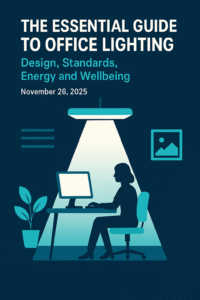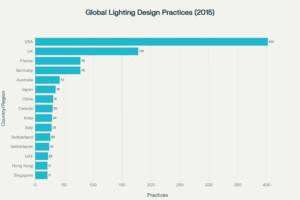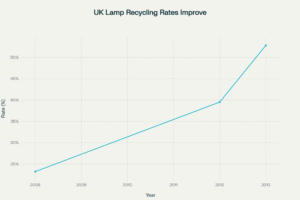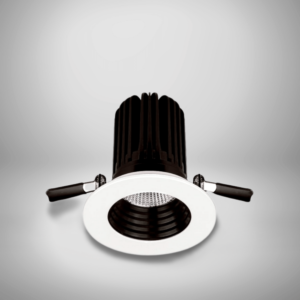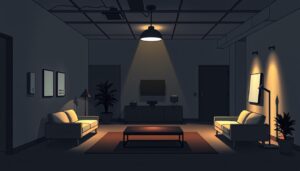Have you ever considered that the lighting in your office could be silently shaping your team’s productivity and wellbeing?
We’re exploring the fascinating connection between environmental lighting and cognitive function. The right illumination does more than just help us see—it actively influences our mental states throughout the day.
Our brains respond directly to different lighting conditions. Specific colour temperatures and intensity levels can boost concentration or promote relaxation. This knowledge enhances our ability to design commercial and residential spaces.
For facility managers and lighting consultants, understanding this relationship is crucial. Strategic lighting choices create environments that support both human health and sustainable energy use.
We’ll show you practical applications from cutting-edge research. Discover how simple adjustments can optimise workplaces and living spaces for better performance.
This aligns with our mission to create regenerative lighting solutions. We focus on designs that enhance human experience while eliminating lighting-related e-waste.
Understanding the Impact of Lighting on Mood and Performance
Environmental illumination serves as a powerful regulator of human physiology and cognitive function. Our biological systems respond directly to the quality and timing of the light around us.
This relationship forms the foundation for understanding circadian rhythms and photoreception. Proper illumination design can significantly enhance both wellbeing and productivity in commercial spaces.

The Role of Daylight and Environmental Cues
Natural daylight acts as our primary environmental cue. It synchronises our internal biological clocks throughout the working day.
This synchronization regulates hormone production and alertness levels. Different wavelengths signal specific brain regions, triggering physiological responses.
Artificial illumination in commercial settings must support these natural processes. Poor design can disrupt employee productivity and long-term health outcomes.
How Lighting Shapes Our Emotions
Certain light qualities make spaces feel welcoming, energising, or calming. This emotional dimension is essential for retail environments and office design.
Inadequate illumination contributes to workplace fatigue and reduced performance. Investing in quality infrastructure becomes a business necessity for occupant satisfaction.
Strategic lighting choices create environments where people truly thrive. They support both human health and sustainable energy use simultaneously.
Scientific Principles Behind Light's Effect on the Brain
Groundbreaking studies show that specific thoughts create distinct, measurable signatures in the brain, a principle that extends directly to how we process environmental illumination. Our mental states have a tangible electrical basis, which different lighting conditions can actively influence.
This foundational research empowers us to move beyond theory into evidence-based design. We can now understand precisely how illumination triggers specific neural pathways.
Brainwaves and Neural Activation
Our brain operates on various electrical frequencies, known as brainwaves. Alpha waves promote relaxation, while beta waves are linked to focused concentration.
Specific illumination can encourage these states. For example, cooler, brighter light often boosts beta activity for alertness.
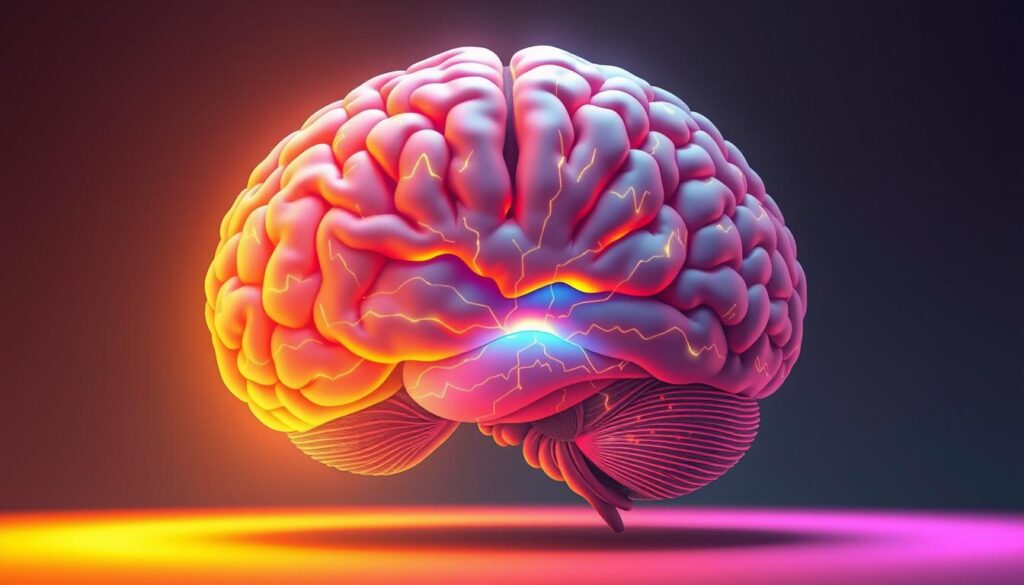
Seminal research published in Nature demonstrated this clearly. Scientists used Brain-Computer Interfaces (BCIs) to record neural activation when patients imagined movements.
This proved that thoughts activate precise brain areas consistently. Environmental factors like illumination quality and timing work on the same principle, triggering pathways that govern our mind.
Specialised photoreceptors in our eyes, called ipRGCs, are key. They respond to specific wavelengths and send this information directly to brain regions controlling alertness and circadian rhythms.
Understanding this science is crucial for facility managers. It means lighting choices are not just about visibility; they are a tool for supporting optimal cognitive function at the right time of day.
Using Light to Change Your Mind: Practical Applications
Simple adjustments to your current lighting infrastructure can yield immediate improvements in occupant wellbeing and productivity. We translate complex neuroscience into straightforward strategies that work across commercial and residential settings.
Actionable Lighting Techniques for Daily Life
Start with morning exposure to bright, cool-white illumination around 500 lux. This signals your body’s internal clock for optimal alertness. Colour temperatures of 5000-6500K work best during peak working hours.
Different environments require tailored approaches. Offices benefit from dynamic systems that adapt throughout the day. Retail spaces need illumination that enhances product appeal while maintaining customer comfort.
Industrial facilities require consistent, high-quality illumination for safety and reduced fatigue. Each setting has unique requirements that impact both performance and health outcomes.
Integrating Research Insights into Everyday Routines
Evening routines should minimise blue spectrum exposure to protect sleep quality. Warmer tones below 3000K support natural wind-down processes. This simple adjustment benefits shift workers and standard office staff alike.
Conducting basic audits identifies quick-win improvements. Look for opportunities to enhance existing systems rather than complete overhauls. This approach delivers immediate benefits while supporting long-term health.
Proper design creates significant returns through reduced energy consumption and improved occupant satisfaction. It represents a win for both sustainability and human-centric design principles.
Innovative Technologies in Lighting and Brain Research
We are entering an era where illumination technology is converging with cutting-edge brain science. This fusion is creating powerful new tools for understanding and influencing cognitive function.
These advancements provide unprecedented insights into how our brains process environmental cues.
Brain-Computer Interfaces and Future Possibilities
Research into Brain-Computer Interfaces (BCIs) has shown remarkable results. Tetraplegic patients can control external devices through thought alone.
This demonstrates that precise neural activation patterns can be translated into commands. It reveals the brain’s incredible capacity for communication.
Optogenetics: Triggering Memories with Light
A groundbreaking study from MIT, published in Nature, utilised optogenetics. This technique uses light to control genetically modified neurons.
Scientists focused on the hippocampus, a critical brain region for memory. They inserted light-sensitive proteins into neurons and created a fear memory in mice.
Later, directing light onto just a few neurons triggered the entire memory. This research fundamentally changed our understanding of neural information storage.
Introduced in 2004, optogenetics offers superior speed and precision over older methods. It can control small neuron subsets on millisecond timescales.
This earned it the designation of Method of the Year in 2010. The potential applications extend to studying depression, Parkinson’s, and anxiety.
Real-Life Case Studies and Experimental Insights
These discoveries have profound implications for our world. At Brown University, researchers are developing wireless optical electrodes for human brains.
This opens possibilities for future therapeutic memory enhancement. It suggests that illumination technologies could offer benefits beyond simple visibility.
For facility managers, this research provides critical information. It underscores why lighting design must be considered a genuine health intervention.
Staying informed allows organisations to adopt next-generation solutions. These deliver measurable benefits for occupant health and performance over time.
Designing Your Lighting Strategy for Better Health and Sleep
Strategic illumination design bridges the gap between workplace efficiency and personal wellbeing. We help organisations create systems that support natural body rhythms throughout the entire day.
A proper lighting plan considers both active working hours and essential recovery periods. This approach delivers significant benefits for occupant health and organisational performance.
Optimising Day and Night Light Settings
Daytime illumination should promote alertness and energy. We recommend cooler colour temperatures between 5000-6500K with adequate intensity levels.
Night-time settings require warmer, dimmer options to support sleep quality. This distinction is crucial for facilities operating around the clock.
| Time Period | Colour Temperature | Intensity (Lux) | Health Benefit |
|---|---|---|---|
| Day (6am-6pm) | 5000-6500K | 300-500 | Enhanced alertness |
| Evening (6pm-10pm) | 3000-4000K | 100-200 | Wind-down preparation |
| Night (10pm-6am) | 2700-3000K | 50-100 | Sleep protection |
Tunable white systems automatically adjust throughout the day. They mimic natural patterns without manual intervention.
This strategic approach supports circadian health while reducing energy consumption. It represents smart design that benefits both people and planet.
Conclusion
The evidence is clear: strategic illumination planning represents one of the most impactful investments organisations can make for their workforce. Proper environmental light does far more than enable visibility—it actively shapes cognitive performance and emotional wellbeing.
Facility managers and consultants can implement immediate improvements. Adjusting colour temperatures and designing circadian-supportive systems creates environments where people thrive. The role of evidence-based design cannot be overstated for sustainable outcomes.
This aligns with our mission to develop fully regenerative lighting solutions. We believe future systems must adapt as our understanding of light’s effect on the human mind evolves. View illumination as an investment delivering measurable returns through enhanced productivity and health.
We invite professionals to reassess current strategies through this neuroscience lens. Identify opportunities where upgraded systems benefit both occupants and environmental sustainability. The transformative role of proper light awaits those ready to embrace this approach.
FAQ
How does lighting actually affect my mood?
Lighting directly influences our circadian rhythms and the production of hormones like melatonin and cortisol. Bright, cool-toned light during the day can boost alertness and concentration, while warmer, dimmer light in the evening helps signal to our body that it’s time to wind down for sleep, positively affecting our emotional state.
What is the best type of lighting for an office environment?
For optimal performance in a workspace, we recommend lighting that mimics natural daylight. High-quality LED systems with a colour temperature around 4000-5000 Kelvin provide excellent visibility and reduce eye strain. Incorporating dynamic lighting that adjusts throughout the day can further support employee wellbeing and productivity.
Can changing my lighting really improve my sleep?
Absolutely. Exposure to bright blue-rich light in the evening can disrupt your sleep-wake cycle. By using warmer, amber-toned lights and reducing overall brightness a few hours before bed, you support your body’s natural production of melatonin, leading to more restful and restorative sleep.
What role does light play in our overall health?
Light is a crucial environmental cue that regulates far more than just sleep. It affects our energy levels, cognitive function, and even long-term health. Properly timed light exposure helps maintain a robust circadian rhythm, which is linked to improved metabolic health, immune function, and mental wellbeing.
Are there new lighting technologies that can benefit brain function?
Yes, innovations like human-centric lighting (HCL) systems are designed to dynamically change in intensity and colour temperature throughout the day to align with our biological needs. Research into areas like optogenetics continues to reveal how specific light wavelengths can influence neural pathways, paving the way for future therapeutic applications.
How can I design a better lighting strategy for my home?
Focus on creating layers of light. Use brighter, cooler lights in areas for work and concentration, and softer, warmer lights in spaces for relaxation. Prioritise maximising natural daylight and consider smart lighting controls that allow you to automate settings based on the time of day for a seamless, health-supporting environment.


